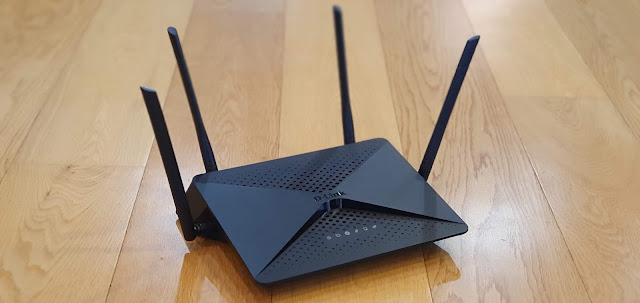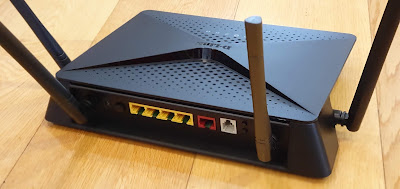
Hands up who's Tech Support at your place?
Mum? Dad? Let's be honest, it's not unusual for the youngest child to know more about how the WiFi works than anyone else in the house.
And if you're in charge of all reboots and updates, that means you're looking after at least one Nana as well.
It's largely a thankless task, as most things are if they involve any teenagers. But when something goes wrong, it's definitely all your fault.
"Dad, the WiFi's not working again!"
"I was halfway through Stranger Things!"
"How'm I s'posed to get my homework done?" (Due tomorrow, left till the last minute)
"Why didn't you return any of my messages?"
"I didn't get any of your messages."
Worst case scenario, you're not even home and you're having to explain how to reboot the modem over the phone.
"No, the modem. The modem. The thing by the TV. With the lights. No, that's a lamp. The modem!"
Give me strength.
Actually, just give me a decent bit of gear....
Compared to some other D-Link modem/routers, the DSL-3900 Viper doesn't actually look like much. There's no brightly coloured shiny casing. There are only four external antennae (not six or even eight) And best of all, it's small enough to fit in my network cupboard.
As funky as those giant technicolour models may be (and it turns out, maybe only tech nerds like me actually think they're funky, some other people I know have even suggested they're weird and ugly and definitely aren't going where anyone can see them) anyway, as "cool" as they are, some of them are pretty huge and oddly shaped and to be honest, don't fit anywhere next to anything.
The DSL-3900 on the other hand is compact, rectangular and black. There's a small D-Link logo embossed on the top - but it doesn't light up or anything silly like that. In fact, there's just the usual row of status indicators and they're not particularly sparkly. In short, this probably isn't a device that's going to make someone say, "What the hell is that?" when they get home to see you've replaced that slow, entry-level modem/router your ISP sent you for free.
The first feature of the DSL-3900 that had me smiling was the number of ethernet LAN ports; four of them, not including the WAN-in. Sounds like a little thing, but there are often only two or three ports to spare on more basic devices and if, like me, you're using the Viper as your base unit to distribute high-speed connections throughout the house, any port in a storm is truly welcome.
Once I had the DSL-3900 up and running, there was a noticeable bump in speed on every device connected, all through the house - either via WiFi or plugged in directly. Although my UFB plan promises me 100Mbps I don't think I've ever actually seen anything like that speed, even on my hard-wired desktop until now.
What's more, due to it's MU-MIMO capabilities, the DSL-3900 can deliver those great speeds to multiple devices simultaneously. If you've found streaming HD video gets a bit patchy if someone else in the house is doing it too, or in my case add in some pretty full-on online gaming as well, you simply must upgrade to a device like this.
If you've set up a D-Link device before, you'll be pretty familiar with the browser-based interface. It gives you the option of a set-up wizard, which walks you through each part of the process step by step, or you can just input your settings manually. This is usually what I end up doing because for some reason, UFB connections seem to be slightly complicated but never fear, most ISP's provide a list of settings you need on their websites.
Apart from setting up your internet connection and creating your home WiFi network, the other great feature you can access via the browser interface is the USB media server. There's a USB 3.0 port on the front of the DSL-3900 which means you can plug in as much external storage as you like. Then you simply enable the DLNA Media Server and Windows File Sharing options and you can access your storage from any device connected to the network; phones, tablets, PC's or even smart TV's.
I've used this feature (or features like it) on other routers, but they've always been strangely unreliable. The server would be discoverable one day, but not the next. Or it would disappear when rebooting the router. I haven't had any issues like that with the DSL-3900. I simply plugged in my external drive, it appeared in the settings and it's been working perfectly ever since. Happiness is an easily accessible media server, don't you think? (Such a nerd)
Reliability really is the big thing that keeps shining through with the DSL-3900. I haven't had to reboot it since I connected it, it just keeps working. I have about 45 devices that regularly access my home network one way or another. If you think that sounds like a lot, it's actually only slightly above average. Start counting all the phones, iPads, laptops, speakers and tellies at your place and you might be surprised. The last thing you need with all that traffic is a choke point at the router - after all, it's no use having UFB or VDSL connection if the flow from that pipe is getting clogged up as soon as it enters the house.
Installing the DSL-3900 has cleared the way at my place, with faster, more reliable access all over my house. I love not having to reboot.
Click here for more information on the D-Link DSL-3900 Viper 2600 Modem Router.
Take your Radio, Podcasts and Music with you











